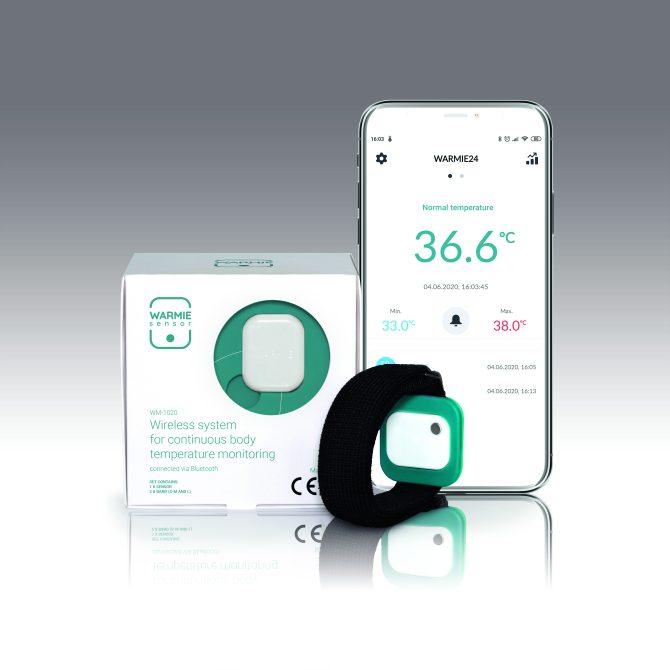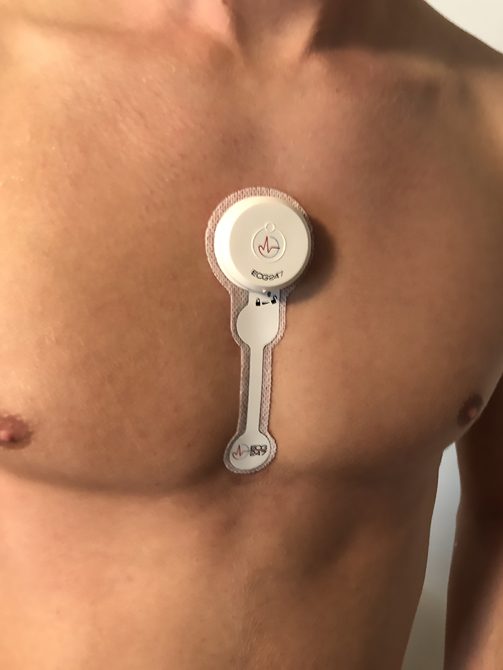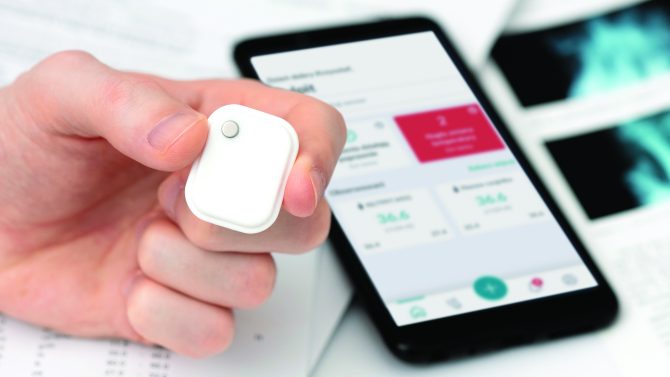
Advanced wearables are moving beyond fitness
By Thomas Soderholm, business development manager - health, Nordic Semiconductor
Electronics Editor Pick medical wearableAlive & Ticking: an estimated 325-million people are using wearables worldwide
When 45-year-old Florida resident Jason Saucier woke up feeling unwell he did as many of us did before the pandemic, brushed it off as nothing serious and went to work. When he later put on his Apple Watch it started making a sound he had never heard before. On looking at his smartwatch it told him he was in ‘aFib’ or atrial fibrillation, a type of heart condition that can increase your risk of stroke and other serious heart complications. Saucier wisely decided to head to the emergency room at his local hospital where the doctors confirmed what his smartwatch had been urgently trying to tell him – he was close to going into cardiac arrest.
Saucier is not alone. With an estimated 325-million people using wearables worldwide, you don’t have to look far to find other examples of wearable technology that has saved lives. Be it smartwatches notifying emergency services when their fall detection sensor is triggered, or electrocardiogram (ECG) functionality detecting an irregular heart rhythm, increasingly powerful wearables have evolved from the activity trackers and calorie counters of a decade ago. Today, these devices not only help keep their owners fit, they also notify them of potential medical emergencies and offer valuable physiological insights to help prevent disease.
Live long and prosper
Beyond consumer demand, other factors have also converged to drive the development and uptake of increasingly sophisticated wearables, not least COVID-19. The pandemic and the stress it placed on global healthcare systems saw the fast-tracking of countless IoT-based devices and ‘ehealth’ wearables. The U.S. Food and Drug Administration (FDA)—responsible for ensuring the safety and efficacy of medical devices in the country—grappled with how to regulate the new technology that blurred the lines between consumer gadget and medical device, but at the same time had the potential to reshape how the healthcare system managed the COVID-19 crisis. Ultimately the pandemic forced a rethink.

Warmie produces medical grade wearable wireless temperature sensors. Source: Warmie
In March 2020 the FDA issued a new policy allowing manufacturers of certain FDA-cleared, non-invasive, vital sign-measuring devices to expand their use so health care providers could use them to monitor patients remotely, including wearables that measure body temperature, respiratory rate, heart rate and blood pressure.
“Allowing these devices to be used remotely can help health care providers access information about a patient’s vital signs while the patient is at home, reducing the need for hospital visits and minimizing the risk of exposure to coronavirus,” said FDA Principal Deputy Commissioner Amy Abernethy, M.D., Ph.D.
Such devices provided a key early warning system about the likelihood of COVID-19 infection by monitoring an individual’s physiological data such as blood oxygen saturation, respiratory rate, heart rate and temperature. At the same time the devices used AI and deep learning for infection surveillance in different scenarios from screening to contact tracing. The FDA’s seal of approval, while welcome, came too late for some.

AppSens’ ECG247 Smart Heart Sensor detects cardiac arrhythmia. Source: AppSens
“If health systems had accelerated the adoption of [wearable] technology available over the past few years, the magnitude of the current pandemic would likely have been much less severe,” said Asma Channa, an early stage researcher from the Polytechnic University of Bucharest, in a paper titled The Rise of Wearable Devices during the COVID-19 Pandemic. “The potential of wearables in healthcare is enormous … [but] wearables must have multifunctional capabilities and be easily configurable.”
Transforming healthcare
While the SARS-CoV-2 virus has helped accelerate the development of multifunction wearables, they are now equally playing a vital role in the prevention and management of a host of other diseases from the physiological—diabetes, hypertension and sleep apnea, for example—to neurocognitive disorders such as Parkinson’s disease and Alzheimer’s. They are also proving their worth for drug delivery applications.
In so doing they are driving a transition in healthcare from a conventional doctor-patient relationship, where diagnosis and treatment was previously based on a fragmented medical history and medical records, to a digitally mediated consumer-led model. That latter model makes it possible to generate rich data sets that enable health providers to offer more personalized health decisions, make earlier diagnoses, perform remote patient tracking and ensure prescription adherence.
The medical profession is largely in favour of the potential of wearables for patient care but advise caution, particularly if the onus will be on physicians to sort through the massive amount of data the devices collect.

The medical profession is largely in favour of the potential of wearables for patient care but advise caution.
“The engineers have been able to give us all this data and create all these sensors for us,” Dr Mohamed Elshazly, a cardiac electrophysiologist at the Cleveland Clinic told The Verge. “Now it’s up to us to analyse that data and figure out how to make clinical sense of it.” To do so, Dr Eric Topol and Lionel Tarrasenko, a biomedical engineer known for developing early-warning systems in critical care, said medicine needed to take a lesson from the aviation industry.
Writing in the international peer-reviewed medical journal, JAMA, the pair said jet engines with 100,000 individual parts are monitored constantly with readings taken on temperature, pressures, shaft speeds and vibrations. Machine learning (ML) is used to detect when readings veer from established patterns and produce early warnings that unscheduled maintenance is needed.
“The full potential of health monitoring for people will only be realized when individualized models underpin the monitoring algorithms,” the authors wrote. “Prospective validation that it promotes health, rather than exacerbates false alarms, will be vital.”
Wearable AI & ML
While they may not be able to supervise a modern jet engine, the SoCs and SiPs that power the latest generation of advanced wearables are well equipped to oversee the requirements of even the most sophisticated medical wearables. This includes support for the ML algorithms that will be needed to sift huge volumes of data for signs that things are going wrong.
“Computing on edge devices such as wearables is getting progressively more energy efficient and powerful while algorithms are more streamlined and energy optimized,” says Petter Myhre, Nordic’s head of product marketing. Myhre says that in the future these developments will allow high-end SoCs and SiPs running ML routines to rapidly establish data anomalies that could indicate underlying health issues. In so doing, the chips have the potential to allow wearable developers to explore ways to selectively provide doctors with just the information they need to make rapid clinical decisions.
Making sense of massive data
Developers are already taking heed. In response to the pandemic, Polish medical start-up Warmie developed a battery-powered, medical grade wearable wireless temperature sensor. The device is designed to rapidly detect changes in body temperature, providing localized continuous temperature and infection monitoring of post-operative surgical wounds in and out of hospital. It is designed to be easily integrated into other telemedicine systems so the body temperature of many patients can be reviewed simultaneously from a single web-based dashboard, without having to attend to the patient in person.
“Because temperature measurements are traditionally taken manually several times a day, they often miss critical changes that can signify an infection,” says Warmie’s Professor Tomasz Banasiewicz, M.D. PhD. “And, infections left untreated can quickly become more widespread within the body and thus much harder to treat.”
The Warmie Sensor is powered by Nordic Semiconductor’s nRF52810 SoC and its 64 MHz, 32-bit Arm Cortex-M4 processor that enables the device to not only record single-point temperature measurements but also evaluate patterns of temperature changes that can be spread over several parts of the body, and alert clinicians or users of potential health risks.

The Warmie Sensor is powered by Nordic Semiconductor’s nRF52810 SoC and its 64 MHz, 32-bit Arm Cortex-M4 processor that enables the device to not only record single-point temperature measurements.
“Body temperature changes throughout the day … so it is more accurate to assess many time series measurements and perform pattern recognition in comparison to an individual patient’s baseline,” continues Banasiewicz. “This gives significantly more accurate results compared to traditional manual temperature measurement methods.”
Another company developing wearable products that offer benefits to both the medical sector and consumers is Norwegian tech manufacturer, AppSens. The company’s ECG247 Smart Heart Sensor is a wearable ECG heart monitor designed to detect atrial fibrillation and other cardiac arrhythmias. Medical professionals can use the platform to remotely monitor and screen people who are at increased risk of stroke due to heart rhythm disorders or who have symptoms of rhythm disorders such as palpitations or fast heart rate. The solution can also be used by patients to self-test their own heart health, including during exercise or activity.
The device consists of a disposable electrode-patch to fasten the sensor to the patient’s chest and a reusable electronic component to achieve reliable electrical connection for the measurement of ECG signals. The integrated SoC’s processor not only supervises the wearable’s integrated sensors but also supports the complex computations necessary to run the proprietary algorithms for measuring and analysing the heart’s electrical activity.
As wireless wearables transition to multifunction medical solutions, their ability to further disrupt healthcare will in part depend on the AI, ML, augmented reality and big data capabilities of the tiny chips inside, as well as the FDA’s willingness to accept their role in a highly regulated sector. When this happens, researchers claim, the next step for wearables will be to provide the healthcare system with a value-added emphasis on diagnosis, treatment, tracking and prevention.
With healthcare consuming 18% of GDP in the U.S., equivalent to $3.6-trillion a year, the prize for the developers of the technology will be huge.

Professor Tomasz Banasiewicz, M.D. PhD provides technical supervision to Warmie.
